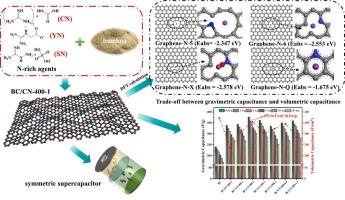Controllable synthesis of N-rich defective carbon materials for aqueous supercapacitors: Towards a trade-off between gravimetric and volumetric capacitance
IF 8.9
2区 工程技术
Q1 ENERGY & FUELS
引用次数: 0
Abstract
The conversion of biomass into porous carbon with high specific surface area (SSA) could be applied in the field of supercapacitors, which realised the resourceful use of biomass. However, the increase in SSA provided carbon materials with lower volumetric capacitance, thereby limiting the development of carbon-based supercapacitors (SCs). To trade off gravimetric and volumetric capacitance, the active nitrogen doping strategy was an effective route. Herein, nitrogen-rich micro-mesoporous composite carbon materials were synthesised from forestry waste (bamboo) as raw material, with guanidine carbonate as N-rich agent and KHCO3 as green activator. The N-rich agent exhibited multiple roles in the co-pyrolysis process, which were pore creation and heteroatom doping. In this paper, the correlation between the type of N-rich agent, the addition amount and the pre‑carbonization temperature and the electrochemical properties of carbon materials were investigated. Due to the multifunctionality of guanidine carbonate, the carbon material exhibited excellent SSA (1469.14 cm2/g), outstanding microporous structure, and abundant reactive N sites, which facilitated the efficient transport of electrolyte ions. Among them, the best carbon material (BC/CN-400-1) showed a high gravimetric capacitance of 376.25 F/g, demonstrating a volumetric capacitance of 355.54 F/cm3 at the same time. In addition, the aqueous symmetrical supercapacitor (BCN//BCN) displayed remarkable cycling stability (94.35 %). The BCN//BCN achieved an energy density of 15.64 Wh/kg at a power density of 75 W/kg. In summary, this study proposed a controllable N-atom doping technique, which offered a feasible route for the synthesis of N-doped hierarchical nanomaterials. Meanwhile, using forestry wastes as raw materials for the preparation of high-performance carbon-based supercapacitors facilitated resources utilization of biomass and sustainable development, providing a reference for the fabrication of N-rich biomass-derived carbon materials.

用于水性超级电容器的富含 N 的缺陷碳材料的可控合成:实现重力电容与体积电容之间的权衡
将生物质转化为具有高比表面积(SSA)的多孔碳可应用于超级电容器领域,从而实现生物质的资源化利用。然而,比表面积的增加使碳材料的体积电容降低,从而限制了碳基超级电容器(SC)的发展。为了权衡重量电容和体积电容,活性氮掺杂策略是一条有效的途径。本文以林业废弃物(竹子)为原料,以碳酸胍为富氮剂,以 KHCO3 为绿色活化剂,合成了富氮微多孔复合碳材料。富氮剂在共热解过程中表现出多种作用,包括孔隙生成和杂原子掺杂。本文研究了富N剂的种类、添加量和预碳化温度与碳材料电化学性能的相关性。由于碳酸胍的多功能性,碳材料表现出优异的 SSA(1469.14 cm2/g)、突出的微孔结构和丰富的活性 N 位点,从而促进了电解质离子的高效传输。其中,最好的碳材料(BC/CN-400-1)显示出 376.25 F/g 的高重力电容,同时显示出 355.54 F/cm3 的体积电容。此外,水基对称超级电容器(BCN//BCN)显示出显著的循环稳定性(94.35%)。在功率密度为 75 W/kg 时,BCN//BCN 的能量密度达到了 15.64 Wh/kg。总之,本研究提出了一种可控的 N 原子掺杂技术,为合成 N 掺杂的分层纳米材料提供了一条可行的途径。同时,以林业废弃物为原料制备高性能碳基超级电容器,有利于生物质的资源化利用和可持续发展,为制备富含 N 的生物质源碳材料提供了参考。
本文章由计算机程序翻译,如有差异,请以英文原文为准。
求助全文
约1分钟内获得全文
求助全文
来源期刊

Journal of energy storage
Energy-Renewable Energy, Sustainability and the Environment
CiteScore
11.80
自引率
24.50%
发文量
2262
审稿时长
69 days
期刊介绍:
Journal of energy storage focusses on all aspects of energy storage, in particular systems integration, electric grid integration, modelling and analysis, novel energy storage technologies, sizing and management strategies, business models for operation of storage systems and energy storage developments worldwide.
 求助内容:
求助内容: 应助结果提醒方式:
应助结果提醒方式:


